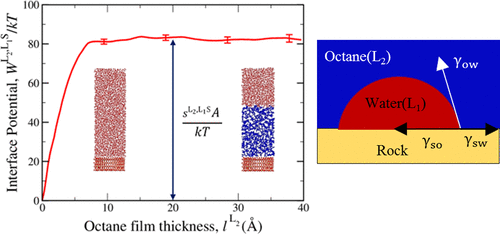当前位置:
X-MOL 学术
›
J. Phys. Chem. C
›
论文详情
Our official English website, www.x-mol.net, welcomes your feedback! (Note: you will need to create a separate account there.)
Monte Carlo Simulation Strategies to Compute the Interfacial Properties of a Model Octane–Water–Silica System
The Journal of Physical Chemistry C ( IF 3.7 ) Pub Date : 2018-07-19 , DOI: 10.1021/acs.jpcc.8b04993 Wenjing Guo 1 , Jeffrey R. Errington 1
The Journal of Physical Chemistry C ( IF 3.7 ) Pub Date : 2018-07-19 , DOI: 10.1021/acs.jpcc.8b04993 Wenjing Guo 1 , Jeffrey R. Errington 1
Affiliation

|
We use Monte Carlo simulation to study the wetting properties of a model octane–water–silica system. Two versions of the interface potential are employed to characterize the wetting behavior. The water spreading interface potential focuses on the growth of a water-rich film from a silica surface in the presence of an octane-rich fluid. The octane spreading interface potential focuses on the growth of an octane-rich film from a silica surface in the presence of a water-rich fluid. These interface potentials provide direct measures of two spreading coefficients that are combined to obtain the octane–water interfacial tension and the contact angle of a water-rich droplet at a silica surface in a mother octane-rich fluid. We demonstrate how to utilize the approach to determine the interfacial properties of a model system (SPC/E water, TraPPE octane, and Lee and Rossky silica) over a wide range of temperatures and pressures. Results are presented for the variation in the interfacial tension and the contact angle with pressure at a constant temperature and along the liquid–liquid–vapor triple line. Finally, we briefly examine how wetting properties vary upon modification of the surface hydrophilicity.
中文翻译:

计算模型辛烷-水-二氧化硅系统界面特性的蒙特卡洛模拟策略
我们使用蒙特卡洛模拟研究辛烷-水-二氧化硅模型系统的润湿特性。界面电位的两个版本用于表征润湿行为。扩水界面电势集中在富辛烷值流体存在下从二氧化硅表面生长出富水膜。辛烷扩散界面电势集中在富水流体存在下从二氧化硅表面生长富辛烷薄膜的过程中。这些界面电势提供了两个扩展系数的直接量度,将它们结合在一起即可获得辛烷-水界面张力和母辛烷富集流体中二氧化硅表面的富水液滴接触角。我们演示了如何利用该方法确定模型系统的界面特性(SPC / E水,TraPPE辛烷,以及Lee和Rossky硅胶)在很宽的温度和压力范围内。给出了在恒定温度下以及沿液-液-汽三重线的界面张力和接触角随压力的变化的结果。最后,我们简要检查了润湿性能如何随表面亲水性的改变而变化。
更新日期:2018-07-20
中文翻译:

计算模型辛烷-水-二氧化硅系统界面特性的蒙特卡洛模拟策略
我们使用蒙特卡洛模拟研究辛烷-水-二氧化硅模型系统的润湿特性。界面电位的两个版本用于表征润湿行为。扩水界面电势集中在富辛烷值流体存在下从二氧化硅表面生长出富水膜。辛烷扩散界面电势集中在富水流体存在下从二氧化硅表面生长富辛烷薄膜的过程中。这些界面电势提供了两个扩展系数的直接量度,将它们结合在一起即可获得辛烷-水界面张力和母辛烷富集流体中二氧化硅表面的富水液滴接触角。我们演示了如何利用该方法确定模型系统的界面特性(SPC / E水,TraPPE辛烷,以及Lee和Rossky硅胶)在很宽的温度和压力范围内。给出了在恒定温度下以及沿液-液-汽三重线的界面张力和接触角随压力的变化的结果。最后,我们简要检查了润湿性能如何随表面亲水性的改变而变化。


























 京公网安备 11010802027423号
京公网安备 11010802027423号